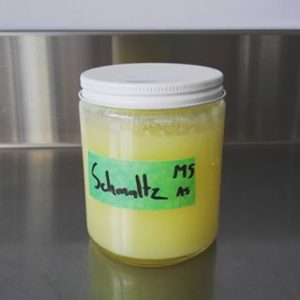
Schmaltz is the Yiddish word for rendered fat, or grease. It is taken from the German Schmalz.[1] I wrote about how to render pork fat here, and the two preparations Grammelschmalz[2] and Schmalzfleisch. While schmaltz can technically refer to rendered fat from any animal, obviously in the context of Jewish cooking we aren’t talking about pork fat. While goose fat was common in Europe, the Jewish emigrants arriving in North America found chicken fat much more readily available, and this remains the default schmaltz in Jewish communities in the new world.
There is quite a different ratio of fat to lean in a chicken than a hog. It is easy to cut away large slabs of subcutaneous fat from a pig, but chickens, especially nowadays, are quite lean. To get chicken schmaltz, pieces of intact chicken skin are cooked to render out the thin layer of subcutaneous fat. It is a rather low yield process (less than 50% by weight) so I like to grind the skin before heating for maximum fat extraction.
Generally in lard production care is taken to not over-cook or brown any of the connective tissue; the goal is a very clean, neutral fat. With schmaltz the chicken skin is browned thoroughly, imparting a distinct, rich flavour to the fat. It is also common to throw sliced onions in the pot.
People often talk about cooking the way their Grandma did. One of the biggest differences in my grandma’s pantry and the typical modern pantry is the cooking fats. Convenient, cheap, liquid vegetable oils were not commonplace until the 1950s. Canola wasn’t even fully developed until the 1970s. Olive oil was not readily available and considered a specialty import for the Italian community. Grandma cooked with pork fat, either rendered lard or bacon grease. It would be inconceivable to make a dish like Aunt Dorie’s fried porridge with canola oil instead of bacon grease.
Likewise chicken schmaltz is absolutely essential for authentic flavour in dishes like matzo ball soup and latkes.
I searched high and low for a commercial schmaltz available in Edmonton and came up empty-handed, so if you want to cook like a bubbie you’ll need to make your own.
Schmaltz
Ingredients
- 1 kg chicken skin
- half an onion, thinly sliced
Procedure
- Grind the skin through a 3/16″ plate.
- Put the ground skin and sliced onion in a heavy pot over medium heat.
- Cook until fat has melted and pooled in the bottom of the pot and the remaining skin has browned and crisped. You will need to stir frequently with a wooden spoon to prevent scorching at the bottom of the pot.
- Strain off the fat by pouring all the contents into a conical strainer. Use the back of a ladle to press the bits of connective tissue and extract more fat.
- You will notice there is a thinner layer of broth-like liquid settled beneath your schmaltz. The schmaltz should be decanted or otherwise separated from this liquid. This will ensure there is no water in your fat, which would cause explosive spattering if heated in a pan. It also will help the schmaltz keep longer in the fridge. The liquid is extremely rich in gelatine and can and should be reserved for use in soup.
Yield: roughly 400 mL schmaltz
Notes
- Yiddish schmaltz and German Schmalz are pronounced the same. The German “z” makes a “ts” sound.
- Grammel is the German word for the small pieces of connective tissue left after pork fat has been rendered. The Yiddish word for the bits of chicken skin that are left after schmaltz is rendered is gribenes.